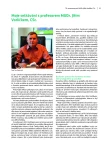Palliative care and chronic heart failure
Authors:
Jiří Vítovec 1; Ladislav Kabelka 2,3; Lenka Špinarová 1; Jindřich Špinar 4
Authors‘ workplace:
I. interní kardio-angiologická klinika LF MU a FN u sv. Anny Brno, přednostka prof. MUDr. Lenka Špinarová, CSc., FESC
1; Dům léčby bolesti s hospicem sv. Josefa, Rajhrad u Brna, vedoucí lékař MUDr. Ladislav Kabelka, Ph. D.
2; Česká společnost paliativní medicíny České lékařské společnosti J. E. Purkyně Praha, předseda MUDr. Ladislav Kabelka, Ph. D.
3; Interní kardiologická klinika LF MU a FN Brno, pracoviště Bohunice, přednosta prof. MUDr. Jindřich Špinar, CSc., FESC
4
Published in:
Vnitř Lék 2014; 60(Suppl 2): 86-90
Category:
70th Birthday - prof. MUDr. Jiří Vorlíček, CSc.
Overview
Heart failure is a very common clinical syndrome in cardiology which reduces life expectancy and has a significant impact on the quality of life. The treatment of heart failure improves survival thus the number of patients who reach the terminal state increases with this diagnosis. Major symptoms and psychosocial difficulties begin to appear during therapy which aims to prolong life or cure the life limiting illnesses. The World Health Organization (WHO) changed its definition in 2002 and concluded that palliative care should be provided "in the early stages of disease, together with another treatment that prolongs life." Palliative care involves multiple disciplines in order to solve problems caused by the symptoms of the disease and other related aspects of the patient and family who are considered as a one subject, because a feeling of well-being has an impact on others.
Key words:
heart failure – non-pharmacological treatment – palliative care
Sources
1. Vorlíček J, Adam Z, Pospíšilová Y et al. Paliativní medicina. Grada: Praha 2004. ISBN 80–247–0279–7.
2. Goodlin SJ, Hauptman PJ, Arnold R. Consensus statement: palliative and supportive care in advanced heart failure. J CardiacFailure 2004; 10(3): 200–209.
3. Clark AL. Origin of symptoms in chronic heart failure. Heart 2006; 92(1): 12–16.
4. Goode KM, Nabb S, Cleland JG et al. A comparison of patient and physician-rated New York Heart Association class in a community-based heart failure clinic. J Card Fail 2008; 14(5): 379–387.
5. Chang VT, Hwang SS, Feuerman M. Validation of the Edmonton Symptom Assessment Scale. Cancer 2000; 88(9): 2164–2171.
6. Opasich C, Gualco A, De Feo S. Physical and emotional symptom burden of patients with end-stage heart failure: what to measure, how and why. J Cardiovasc Med (Hagerstown) 2008; 9(11): 1104–1108.
7. Rector TS, Cohn JN. Assessment of patient outcome with the Minnesota Living with Heart Failure questionnaire: reliability and validity during a randomized, double-blind, placebo-controlled trial of pimobendan. Pimobendan Multicenter Research Group. Am Heart J 1992; 124(4): 1017–1025.
8. Green CP, Porter CB, Bresnahan DR et al. Development and evaluation of the Kansas City Cardiomyopathy Questionnaire: a new health status measure for heart failure. J Am Coll Cardiol 2000; 35(5): 1245–1255.
9. Evangelista LS, Dracup K, Doering L et al. Emotional well-being of heart failure patients and their caregivers. J Card Fail 2002; 8(5): 300–305.
10. Dracup K, Westlake C, Erickson VS et al. Perceived control reduces emotional stress in patients with heart failure. J Heart LungTransplant 2003; 22(1): 90–93.
11. Goodlin SJ, Quill TE, Arnold RM. Communication and decision-making about prognosis in heart failure care. J Card Fail 2008; 14(2): 106.
12. Lee DS, Austin PC, Rouleau JL et al. Predicting mortality among patients hospitalized for heart failure: derivation and validation of a clinical model. JAMA 2003; 290(19): 2581–2587.
13. Levy WC, Mozaffarian D, Linker DT. The Seattle Heart Failure Model: prediction of survival in heart failure. Circulation 2006; 113(11): 1424–1433.
14. Teuteberg JJ, Lewis EF, Nohria A. Characteristics of patients who die with heart failure and a low ejection fraction in the new millennium. J Card Fail 2006; 12(1): 47–55.
15. Derfler MC, Jacob M, Wolf RE. Mode of death from congestive heart failure: implications for clinical management. Am J Geriatr Cardiol 2004; 13(6): 299.
16. Mac Iver J, Rao V, Delgado DH. Choices: a study of preferences for end-of-life treatments in patients with advanced heart failure. J Heart Lung Transplant 2008; 27(9): 1002–1007.
17. Lewis EF, Johnson PA, Johnson W et al. Preferences for quality of life or survival expressed by patients with heart failure. J Heart Lung Transplant 2001; 20(9): 1016–1024.
18. Stevenson LW, Hellkamp AS, Leier CV. Changing preferences for survival after hospitalization with advanced heart failure. J Am Coll Cardiol 2008; 52(21): 1702–1708.
19. Hauptman PJ, Swindle J, Hussain Z et al. Physician attitudes toward end-stage heart failure: a national survey. Am J Med 2008; 121(2): 127–135.
20. Hauptman PJ, Havranek EP. Integrating palliative care into heart failure care. Arch Intern Med 2005; 165(4): 374–378.
21. Peura JL, Colvin-Adams M, Francis GS et al. Recommendations for the Use of Mechanical Circulatory Support: Device Strategies and Patient Selection: A Scientific Statement From the American Heart Association. Circulation 2012; 126(22): 2648–2667.
22. Goddlin SJ. Palliative Care in Congestive Heart Failure. J Am Coll Cardiol 2009; 54(5): 386–396.
23. Friedrich EB, Böhm M. Management of End Stage Heart Failure. Heart 2007; 93(5); 626–631.
24. Špinar J, Vítovec J, Hradec J et al. Czech Society of Cardiology guidelines for the diagnosis and treatment of chronic heart failure 2011. Cor Vasa 2012; 54(2): e113-e134.
25. Sláma O, Kabelka L, Vorlíček J et al. Paliativní medicina pro praxi. 2nd ed. Galen: Praha 2011. ISBN 978-80-7262-871-1 (PDF); 978-80-7262-872-8 (PDF pro čtečky).
Labels
Diabetology Endocrinology Internal medicineArticle was published in
Internal Medicine

2014 Issue Suppl 2
Most read in this issue
- Differential diagnostics of hypereosinophilia
- Palliative medicine and the „good death“
- Patient follow-up after treatment of breast, colorectal and prostate cancer
- Ph-negative myeloproliferative diseases with thrombocythemia in the context of Thromboreductin® treatment, data from registry 2013
